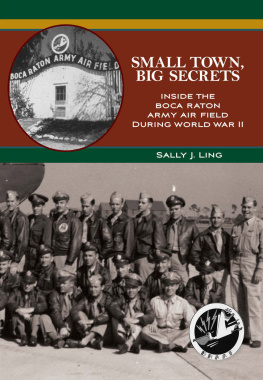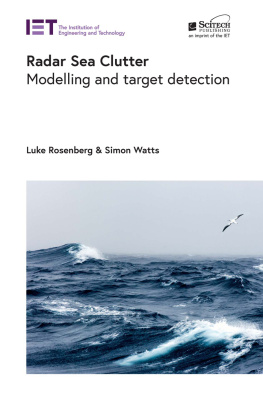SMALL TOWN,
BIG SECRETS
Inside the
Boca Raton Army Air Field
During World War II
Sally J. Ling
Copyright 2012 by Sally J. Ling
All rights reserved
Cover image: Captain Harry Fromme, squadron commander (on left, first one standing), poses with the initial pilots assigned to the Boca Raton Army Air Field. In the background is a B-24. It is believed the two white lines on the nose were made by the photo lab, marking out the number of the aircraft for security reasons. Photo courtesy of Lt. Col. Manuel Chavez USAF (Ret.).
Front Cover inset: The provost marshals office at the main gate. Photo courtesy of the Boca Raton Historical Society.
Back cover inset: Lieutenant Jacob Beser poses in front of the Enola Gay at Roswell, New Mexico. The symbols on the plane are Fat Met and indicate missions the plane flew. Photo courtesy of Leon Smith.
First published 2005, The History Press.
Second Edition 2012.
Notice: The information in this book is true and complete to the best of our knowledge. It is offered without guarantee on the part of the author. The author disclaims any liability in connection with the use of this book.
All rights reserved. No part of this book may be reproduced or transmitted in any form whatsoever without the written permission from the author except in the case of brief quotations embodied in critical articles and reviews.
Dedicated to the men and women who served on the
Boca Raton Army Air Field.
TABLE OF CONTENTS
P R E F A C E
I moved to Boca Raton in 1976. At the time, I-95 stopped at a two-lane east/west thoroughfare called Glades Road. Boca West was my home for the first year as I worked for the Arvida Corporation as director of club and resort activities. When I moved to Boca Linda West a year later, I drove after work with my little dog Pippin to the campus of Florida Atlantic University. There, we ran on the tarmac of what I was told was once a World War II army airfield. While my father was a B-17 pilot in England during World War II and I grew up a military brat with some knowledge of military history, I had never heard of the Boca Raton Army Air Field. Little did I know 30 years later I would write a book about it.
Its been a glorious journey, one filled with awe and surprise. Awe in that I didnt realize Boca Raton had such a rich heritageone shrouded in mystery and marinated in sweet memories. Surprise because I couldnt understand why someone hadnt told this amazing story before. But as I started my research, that reason became abundantly clear.
Information about the Boca Raton Air Field did not come neatly packaged like a gift to be opened. Instead, it came disguised as an oniona big Vidalia onion. As I peeled away each sweet layer, more and more layers were revealed. Because there werent any books written on the subject, it was necessary to review the few relevant articles in newspapers and periodicals, comb through reams of historical military documents, converse with military and civilian experts and historians, and locate dozens of veterans who once served at the field.
Many leads pointed to former military bases and archives where additional information could be gleaned, yet much documentation had been destroyed, and most of the historians I spoke with had never even heard of the Boca Raton Army Air Field. But its no wonder. In those days, when secrets really were secrets, the Boca Raton Army Air Field was top secret. No one talked about it, therefore no one knew about it. The old military sayingthe need to knowwas very much alive and well; our nations future depended upon it.
The thunder of B-17 bombers is now but a whisper and the need for secrecy that surrounded the Boca Raton Army Air Field faded long ago. In this book, I hope to preserve the history and memories of an important time not only in world history but in the history of Florida, the town of Boca Raton and Florida Atlantic University.
Thank you for allowing me to share this extraordinary story with you.
Sally J. Ling
I N T R O D U C T I O N
From its inception, the Boca Raton Army Air Field was steeped in secrecy. Still today, some secrets exist. But its precisely these secrets that give this story its flavor, and while many of these secrets will be revealed, some will remain hidden. Maybe forever.
The story of the Boca Raton Army Air Field (Boca Raton Army Air Field) does not begin in Boca Raton, Florida, with the October 15, 1942 official opening of the secret military installation, as some might believe. Nor does it begin in Washington, D.C., years earlier with discussions by top military brass regarding the construction of new bases to support the war effort. Instead, it begins in England with the invention of a device called RADAR (Radio Detection and Ranging)a device that changed the world.
While the German physicist Henrich Hertz began experimenting with radio waves in 1887, it wasnt until 1935 that British physicist Sir Robert Watson-Watt produced the first practical radar system. By 1940, Germany, Great Britain, France and the United States all used radar to navigate ships and planes as well as detect enemy craft. But it was the invention of the next generation of radar that instilled the greatest hopes of positioning Britain ahead of Germany and allowed the Allies to win the war.
Radar changed the world, and it changed Boca Raton forever. From a sleepy town of 700 in 1940, to the thriving Boca Raton Army Air Field that housed tens of thousands of troops from 1942-1947, to over 195,000 residents who inhabit Greater Boca Raton today, it was radar that played the central role in this makeover.
If we are to truly understand the effect radar had on the transformation of Boca Raton, it is important we take a step back to 1940 where the stage was being set by British and American scientists, military experts, and politicians for this transformation to begin.
(Since its invention, the word RADAR has become more common and is now lowercase, even though it is an acronym.)
1940
SECRET BEGINNINGS
Edward Taffy Bowen threaded his way through the crowded Euston Station in London, England, on August 29, 1940, desperately trying to follow the porter who balanced the precious cargo unsteadily on his shoulder. Should the porter inadvertently lose his grip and the box go crashing to the floor, it would bathe the platform in Britains most valuable military secretsblueprints and circuit diagrams for rockets, gyroscopic gun-sights, submarine detection devices, self-sealing fuel tanks, and even the early designs of the jet engine and atomic bomb. Yet, none of these technological advancements compared to the one device contained within the box Britain considered its most closely guarded secretthe resonate cavity magnetron.
A small device that fit in the palm of your hand, it resembled a clay pigeon used in skeet shooting with a few wire leads attached. Invented just eight months earlier by Birmingham University physicists J.T. Randall and H.A.H. Boot, the cavity magnetron packed a powerful punch with its ability to send out pulses of microwave radio energy on a wavelength just shy of ten centimeters, an astounding one-fifteenth the size of the standard, airborne radar transmissions then in existence. Current radar, operating with wavelengths of between ten and thirteen meters, could identify a target only within a several mile range; pin pointing the objective required visual correction by the pilot. With the new cavity magnetron, however, military aircraft would be able to distinguish rising U-boat periscopes from waves on the darkest of nights or identify enemy aircraft through heavy cloud cover.
Buderi put it this way in his book The Invention that Changed the World: Fitted into night-fighters, such a device would generate sharper pulses in a tightly concentrated parcel of energy that would fan out far less during the brief journey to an enemy aircraft and back, making it immensely easier for pilots to home in on their quarry even on the darkest nights.
Next page









